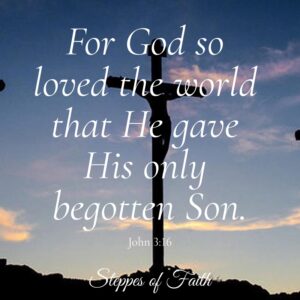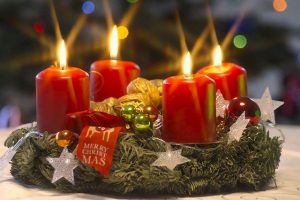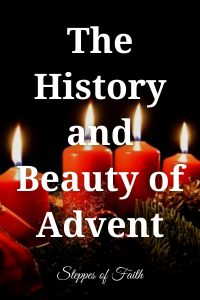
“For God so loved the world that He gave His only begotten Son.” John 3:16
For some people, Advent is simply a time to countdown to Christmas Day. We may have an Advent calendar on the wall made of anything from cloth to wood to Legos, all containing small surprises for children in the build-up to the big day on December 25. But for others, it is the beginning of the liturgical season, a time of gathering to reflect and anticipate the Lord.
The difference in perspectives can be confusing for some. But when we take a closer look at Advent’s history, we discover some reasons why.
Advent comes from the Greek word parousia, a translation from the Latin adventus, meaning “coming.” Parousia refers to Christ’s “coming” in human form and His second divine “coming” during the Tribulation. Its history dates to fourth-century Europe and perhaps further.
Originally occurring in Spain and the ancient regions of Gaul and Hispania, believers used the Advent season to prepare for the baptism of new Christians during the feast of Epiphany in January. During this forty-day season, people would spend time praying, repenting, and fasting as they commemorated:
- The incarnation of Jesus (Matthew 1:18-25; Luke 2:1-20)
- The visit of the Magi (Matthew 2:1-12)
- Jesus’ baptism by John the Baptist (John 1:29-34)
- Jesus’ first miracle at the wedding feast in Cana (John 2:1-10).
Many Eastern cultures still celebrate Advent this way by emphasizing Jesus’ first coming.
The Council of Saragossa
One of the first official pieces of evidence of Advent is found in documents attributed to the Councils of Saragossa, a series of Christian assemblies held in Zaragoza (now Spain). In 380 A.D., a gnostic movement called Priscillianism challenged the Council to respond to one of their heretical claims.
The cultic movement had a dualistic belief that two kingdoms existed: light and darkness. They believed God commanded men to conquer the darkness, but the men failed miserably and were sentenced to remain in human form. They further believed men could only be released from the confines of the earth by the death of a Savior.
As a result, men embody both light and dark kingdoms, the light symbolized by the Light of the Twelve Patriarchs and the darkness by zodiac signs.
The Council of Saragossa challenged the movement by emphasizing the importance of God’s incarnation and how Jesus’ birth counterbalances the powers of darkness. As Christians, we must prepare our hearts to celebrate the Lord’s human birth as well as His return to claim His church one day.
The Council was the first to proclaim that Advent is about both the Lord’s birth (His first coming) and His ultimate return (the second coming)

Four Sundays
The Council’s ruling held for many years, but the Roman Catholic Church did not entirely agree. By the sixth century, the church changed its entire focus of Advent solely to the anticipation of Jesus’ second coming.
However, after the fall of the Roman Empire, Christians shifted their focus again to Jesus’ birth and the celebration of Christmas. Sometime later, they reverted to celebrating both His birth and His future return, a tradition that still holds.
While Eastern countries still traditionally celebrate Advent over forty days in preparation for the Epiphany in January, western countries have reduced it to the last four Sundays leading up to December 25. During this time, believers gather in churches to sing, pray, and read prepared Scriptures together.
The first two Sundays of Advent focus on Christ’s second coming as foretold in Old Testament prophecy. The themes are hope and preparation. The second two Sundays focus on His first coming as retold in the New Testament with themes of joy and love.
The importance of the two parts of Advent is meant to highlight Jesus’ life and point us to where we, the church, are in that period between His birth and His ultimate return.
Hope and Preparation for Christ’s Coming
As families worship together, specific Scriptures are often read aloud in traditional church services during Advent. These readings accompany lighting a new candle on the Advent wreath (see below).
The first Sunday reading is from Isaiah 9:2,6-7.
“The people walking in darkness have seen a great light; on those living in the land of deep darkness
a light has dawned. […] For to us, a child is born; to us a son is given, and the government will be on his shoulders. And he will be called Wonderful Counselor, Mighty God, Everlasting Father, Prince of Peace. Of the greatness of his government and peace, there will be no end. He will reign on David’s throne and over his kingdom, establishing and upholding it with justice and righteousness from that time on and forever. The zeal of the Lord Almighty will accomplish this.”
This first Sunday emphasizes our hope in the promised Messiah. Alternate readings are from Psalm 122, Isaiah 2:2-5, and Romans 13:11-14.
Continuing with the Old Testament, the second Sunday of Advent is also from Isaiah’s book, but this time with a focus on preparing ourselves for Christ’s second coming.
“A voice of one calling: ‘In the wilderness, prepare the way for the Lord; make straight in the desert a highway for our God. Every valley shall be raised up, every mountain and hill made low; the rough ground shall become level, the rugged places a plain. And the glory of the Lord will be revealed, and all people will see it together. For the mouth of the Lord has spoken.'” Isaiah 40:3-5
Additional readings are from Psalm 71:18, Isaiah 11:1-10, and Luke 1:26-38.

The Joy and Love of Advent
The third Sunday turns to the joy of Jesus’ fulfillment of Father God’s promise of a Messiah. Readings are given from the book of Matthew as well as Psalm 146:5-10, Isaiah 35:1-10, and Luke 2:8-14, which all retell Christ’s birth.
“When they saw the star, they were overjoyed. On coming to the house, they saw the child with his mother, Mary, and they bowed down and worshiped him. Then they opened their treasures and presented him with gifts of gold, frankincense, and myrrh.” Matthew 2:10-11
Finally, on the fourth Sunday, a reading from the book of John reminds us of God’s love for His people.
“For God so loved the world that he gave his one and only Son, that whoever believes in him shall not perish but have eternal life. For God did not send his Son into the world to condemn the world but to save the world through him. Whoever believes in him is not condemned, but whoever does not believe stands condemned already because they have not believed in the name of God’s one and only Son. This is the verdict: Light has come into the world, but people loved darkness instead of light because their deeds were evil.” John 3:16-19
Like the other Sundays, additional readings are given from Psalm 24:1-10, Isaiah 7:10-14, Luke 2:8-20, John 1:14, and 1 John 4:10.
Believers come together one last time on Christmas Eve for a final day of adoration of God. Readings are from Psalm 96, Isaiah 9:2-7, Luke 2:1- 40, Titus 2:11- 14, and John 1:14.
“The Word became flesh and made his dwelling among us.”
The Advent Wreath
Instead of hanging colorful calendars to mark Advent, many people mark the season with a unique wreath rich in symbolism.
A German Lutheran minister made the first known wreath in 1839 from the wheel of an old cart decorated with twenty red and four white candles. The minister lit the red candles progressively on the weekdays, and he lit a new white candle on each successive Sunday.
Eventually, people stopped making wreaths from wheels and used evergreen branches instead to symbolize everlasting life. They remained round to symbolize God’s eternal love for us. Some wreaths occasionally include red holly and berries to symbolize Jesus’ death on the cross on our behalf, as well as pinecones to indicate new life and Jesus’ victory over death through His resurrection.

The Wreath Candles
Unlike the early wreaths, today’s wreaths typically have only five candles—four purple ones around the perimeter indicating hope, faith, joy, and peace, and a white candle in the middle to symbolize Jesus’ coming. As the four outer candles are lit each week, specific Scriptures are read aloud (as previously mentioned).
Roman Catholics later adopted the liturgical color violet for Advent commemoration, while others commonly use blue or purple. Some churches still use all red candles with four blue or white candles for each Sunday.
A wreath may also include a pink or rose-colored candle. This candle is lit on Gaudete Sunday, the third Sunday of Advent, to symbolize the nearness of the Lord’s coming (both past and future).
A fifth white candle is commonly placed in the middle of the wreath. This candle is lit on Christmas Day to celebrate Jesus’ birth. Some churches have no wreaths and simply have their congregation light a single white candle instead of lighting the fifth candle of the wreath.
It may be because of the weekly candle lighting that many use Advent as a time to count down to Christmas Day, though Advent is about so much more than keeping track of days. It is a time of celebrating our Lord Jesus Christ.
We do not simply celebrate how Jesus was born in a manger while a brilliant star shone in the sky. It is also how He died on the cross, came to life again three days later, and how, on one incredible day, He will return for His church and conquer wickedness forever.
Whether your church celebrates Advent or not, it is essential to note that it is not a Biblical commandment. It is simply a beautiful act of worship as we remember who Jesus is, what He has done for us, and the assured promise of what He will still do.

I, 84 year old Hindu and a retired engineer, a resident of Delhi, India, have been very fortunate to peruse your remarkable blog ” The difference Between the Kingdom of God and Kingdom of Heaven”. Though a believer in divinity of Jesus Christ I could not understand the gospels well, as I kept searching for spiritual truths there that supplemented my understanding of Hindu texts.
Most scholars say the two Kingdoms [of God and of Heaven] are the same. Based on certain seventeenth century revelations (called Taratam Vani, TV in brief), I very fortunately connected 25 years back with – rather their correlation with reputed Hindu texts – I formed an opinion that they are NOT the same. I want to email to you a write-up that presents an overview of my two books presenting my researches into TV that suggests how Jesus Christ distinguished the two Kingdoms and may well have been respectively the Akashraeeta and Lokas of TV and that mankind is presently passing through the horrendous ‘end times’ and when a spiritual new age will commence. A Loka in ancient Sanskrit means a realm where embodied entities exist, like mankind exists in the world.
Kindly give me email id so that I may send the said write-up K. C. Vyas.